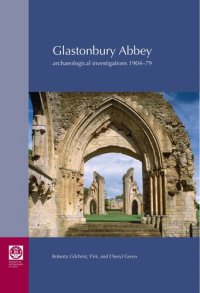
Ebook: Glastonbury Abbey: Archaeological Investigations 1904-79
Author: Roberta Gilchrist Cheryl Green
- Genre: History // Archaeology
- Year: 2015
- Publisher: The Society of Antiquaries of London
- Language: English
- pdf
With contributions from John Allan, FSA, Ron Baxter, FSA, Stuart Black, Paul Courtney, FSA, C. Pamela Graves, FSA, Jane Harcourt, Elizabeth Gardner, Jerry Sampson, FSA, Claire Stephens, Hugh Willmott, FSA, and Kate Welham, and reports on finds by Phil Andrews, FSA, Katherine Barclay, FSA, R. Barnett, Hugo Blake, FSA, Chris Caple, FSA, Dana Challinor, John Cherry, FSA, David Dawson, FSA, Jennifer Durrant, Hella Eckardt, FSA, Geoff Egan, FSA, Alejandra Gutiérrez, Lorrain Higbee, David A Higgins, Michael J. Hughes, FSA, Oliver Kent, Peter Marshall, Ray McBride, Elaine Morris, FSA, Tim Phillips, Roger T. Taylor and Jane Timby, FSA.
Glastonbury Abbey was renowned in the Middle Ages as the reputed burial place of the legendary King Arthur and the site of the earliest Christian church in Britain, believed to have been founded by Joseph of Arimathea in the first century AD. New insights into the abbey's origins and historical development have been revealed by thirty-six seasons of archaeological excavation that took place at the site during the twentieth century, directed by such iconic figures as Sir William St John Hope, Sir Charles Peers, Sir Alfred Clapham and Dr. Courtenay Arthur Ralegh Radford.
The results of these antiquarian excavations, only published in the past in the form of brief interim statements, can now be examined critically for the first time, thanks to a joint project by the University of Reading and Glastonbury Abbey, funded principally by the Arts and Humanities Research Council. This volume reports on the comprehensive study of the archaeological archives and artefact collections and a new geophysical survey. Previous interpretations are challenged and new evidence is presented for the Saxon and later medieval phases of the abbey, including an important complex of early glassworking furnaces, dated c 700. For the first time, archaeological evidence is revealed for the Norman and later medieval monastic ranges and the luxurious abbot's hall and court. The rich assemblage of material culture includes devotional objects, fine imported vessels, locally produced ceramic floor tiles and stained glass and sculpture of the highest quality. Many retrospective elements are evident in the architecture of Glastonbury Abbey, perhaps suggesting a deliberate strategy to cultivate memory and to promote the antiquity of its Christian heritage.
Glastonbury Abbey was renowned in the Middle Ages as the reputed burial place of the legendary King Arthur and the site of the earliest Christian church in Britain, believed to have been founded by Joseph of Arimathea in the first century AD. New insights into the abbey's origins and historical development have been revealed by thirty-six seasons of archaeological excavation that took place at the site during the twentieth century, directed by such iconic figures as Sir William St John Hope, Sir Charles Peers, Sir Alfred Clapham and Dr. Courtenay Arthur Ralegh Radford.
The results of these antiquarian excavations, only published in the past in the form of brief interim statements, can now be examined critically for the first time, thanks to a joint project by the University of Reading and Glastonbury Abbey, funded principally by the Arts and Humanities Research Council. This volume reports on the comprehensive study of the archaeological archives and artefact collections and a new geophysical survey. Previous interpretations are challenged and new evidence is presented for the Saxon and later medieval phases of the abbey, including an important complex of early glassworking furnaces, dated c 700. For the first time, archaeological evidence is revealed for the Norman and later medieval monastic ranges and the luxurious abbot's hall and court. The rich assemblage of material culture includes devotional objects, fine imported vessels, locally produced ceramic floor tiles and stained glass and sculpture of the highest quality. Many retrospective elements are evident in the architecture of Glastonbury Abbey, perhaps suggesting a deliberate strategy to cultivate memory and to promote the antiquity of its Christian heritage.
Download the book Glastonbury Abbey: Archaeological Investigations 1904-79 for free or read online
Continue reading on any device:

Last viewed books
Related books
{related-news}
Comments (0)